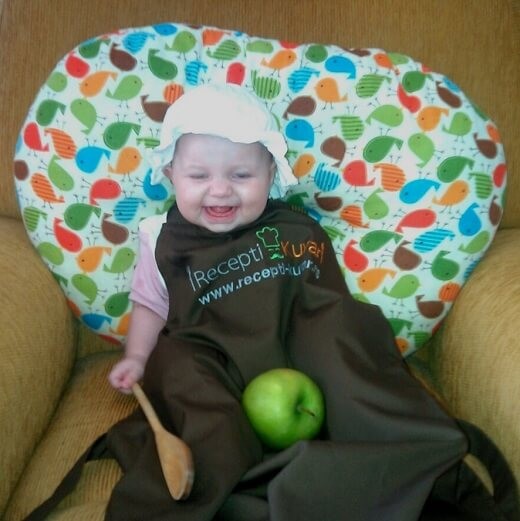Introducing solid food to babies
By now you have probably read a lot of articles on the topic: introducing solid food to babies, and even more heard different advice. At the end of my research, I was even more confused as to which order is correct, which quantity, start time, method of preparation and what is allowed and what is not. Hence the inspiration for this text as a guide that will be understandable to everyone and will enable you to find all the necessary information in one place.
When transitioning to solid food, it does not mean that you will immediately let your baby chew bread and nibble on ribs, until that stage there will be a lot of mixing, pureeing, squeezing and chopping.

INTRODUCING SOLID FOOD TO BABIES - WHEN TO START?
Opinions are divided here, however, there is one general rule that should be adhered to. It should not be started before the 4th month and no later than the 6th month.
At 4 months, the baby's digestive tract matures and can digest food other than breast milk or formula. If you decide to start a little later, know that up to 6 months, breast milk or formula is enough for the baby, and after the 6th month, the baby needs other calories and iron that cannot be found in milk.
How do you know when to start? Monitor your child. Before introducing food into your baby's diet, your child must be able to hold their head up independently and be able to sit up with support.
Advice: Most children will show interest in the food you eat by the time they are 4 months old, watching you carefully and imitating your movements. My advice is to eat at least one meal or snack in front of the child around the 3rd month so that he can see you. In my case, it turned out to be a productive investment of time, because my little one immediately reached for the spoon and put it in her mouth in the correct way. Children respond best to visual stimulation, so never think it's a waste of time.
INTRODUCING SOLID FOOD TO BABIES - HOW TO START?
CEREALS (rice and corn)
Why: These cereals do not contain gluten, so the possibility of an allergic reaction is the least and they are the easiest to digest. You can prepare them yourself or buy ready-made ones that are usually mixed with water and already contain formula. Be sure to prepare them according to the instructions given on the package. Wheat should not be introduced before the 7th month.
When: BREAKFAST + Mother's or formula milk
<strong>Preparation: </strong> Rarely and gradually increase the density
How many: 1 teaspoon, gradually increasing the amount until it replaces the entire meal, i.e. until you eliminate breast or formula milk from the meal. When this becomes a meal, give as much as the child wants to eat, don't force it, but don't give up either.
VEGETABLES (potatoes, carrots, zucchini, pumpkin, broccoli, spinach, Swiss chard, kale, peas, cauliflower)
The introduction of vegetables also depends a lot on the season, but it is important to always buy fresh and not frozen. If a vegetable is not in season, feel free to skip it and introduce it when it is in season in the same way as when you introduced the vegetable for the first time.
Why: Vegetables are introduced before fruits because of its neutral taste and because it does not contain sugar. In practice, it has been shown that in this way, children accept vegetables more easily, than when they start in the reverse order (fruits-vegetables). Therefore, this order is only due to better acceptance of vegetables in the child's diet.
When: LUNCH + Breast milk or formula
<strong>Preparation: </strong> Mashed/thin porridge that can be diluted with breast milk or formula. Vegetables must be pre-cooked.
How many: 1 teaspoon, gradually increasing the amount until the entire meal is replaced, i.e. until you eliminate breast or formula milk from the meal. When this becomes a meal, give as much as the child wants to eat, don't force it, but don't give up either.
Tip: Introduce one vegetable at a time, as follows - potatoes for three days, then carrots for three days and so on. The gradual introduction of one vegetable at a time allows you to recognize the cause if an allergic reaction or any digestive problems occur.
VOWILL (Apples, pears, peaches, apricots, banana, watermelon, melon)
Why: Fruit is rich in vitamins and sugars. It is important that citrus fruits (orange, lemon, grapefruit) they don't introduce it until the 8th month because of the acid that is too strong for the baby's stomach.
Berries (strawberries, blackberries, raspberries, cherries, cherries, blueberries) and pineapple should not be introduced until the FIRST year of life due to the high risk of an allergic reaction.
When: SNACK/Early dinner between 16-17pm
<strong>Preparation: </strong> Raw fruit mashed into a pulp that can be diluted with breast or formula milk.
How many: 1 teaspoon, gradually increasing the amount until the entire meal is replaced, i.e. until you eliminate breast or formula milk from the meal. When this becomes a meal, give as much as the child wants to eat, don't force it, but don't give up either.
Tip: Introduce one fruit at a time, as follows. An apple for three days, then an apricot for three days, and so on. The gradual introduction of one fruit at a time allows you to recognize the cause if an allergic reaction or any digestive problems occur.
Bananas should be given in smaller quantities to children prone to obesity.
JUICE:
Why: Juices can help if constipation occurs.
You can start giving apple juice from the age of 4 months. Peach and apricot juice at 6 months.
When: BETWEEN MEALS
<strong>Preparation: </strong> Squeeze fresh fruit in a juicer.
Quantity: Small quantities so that the juice does not replace a meal.
Advice: Initially, give the juice on a spoon until the child moves on to a hard bottle or glass.
MEAT and FISH
Why: Start with turkey and lamb at 6 months, and after 8 months, introduce chicken, veal and salmon, after you have introduced all the vegetables.
WHEN: LUNCH - mix with vegetables
<strong>Preparation: </strong> Boil and mash.
Quantity: 1 teaspoon next to vegetables. Later you can increase the amount and mix with vegetables.
Advice: Check that the meat does not contain veins, bones and skin. This needs to be removed before giving to a child.
YES / YES
Why: Eggs are introduced only from the age of 8 months to a year and in the following way: First the yolks, and only then the whites from the age of one. In this way, allergic reactions are avoided.
WHEN: BREAKFAST or LUNCH
<strong>Preparation: </strong> Hard boiled egg
Quantity: 1 egg yolk next to the vegetables. Don't overdo it with eggs, and later you can mix the yolk with vegetables.
Advice: Do not give your child eggs more than three times a week.
DAIRY PRODUCTS
Why: Yogurt and kefir can be given to the child after all vegetables and fruits have been introduced into the diet.
Milk and other products can be given to a child only AFTER the first year.
WHEN: 18-19h only if necessary. Later they can be given as a SNACK or mixed into food.
An example of a meal plan start:
| Time/Meal | What food |
| 7h / Breakfast | Cereals + Milk |
| 12:XNUMX / Lunch | Vegetables + Milk |
| 17 pm / Early dinner | Fruit + Milk |
| 22 pm / Dinner | Milk |
*Note: Meals are introduced one at a time. It starts first with the addition of cereals with breakfast, then vegetables with lunch and finally fruits with an early dinner.
Amount of mother's or formula milk when introducing food:
If the child is breastfed then you do not need to monitor the amount, he will only eat as much as he needs, however if you use formula milk, then you need to stick to the amount with which you started the three first meals in which solid food is introduced, because you will increase the amount of food and gradually eliminate milk from the meal.
It's normal: For a child to spit out food surprised by the taste and texture it has never encountered before. Be armed with patience and try slowly and without forcing. It is also normal for him to grab a spoon and take out food with his hands and shove it into his mouth. The introduction of food will soil many of the porticoes, the nests and probably the floors and walls, but this is all normal.
Recommendation: I recommend using a soft pliable silicone spoon to start with because in my experience they are the easiest to accept.
Final tip: Once you've introduced all the vegetables and fruits, you can start mixing flavors and making different porridges, but I'll write about that separately.
Introducing solid food to babies from 6 months to 1 year by Ana Vuletić Anastasijević
READ: WHERE CAN I BUY THE BOOK TRADITIONAL RECIPES OF HOME SERBIAN CUISINE?
Read more:
The best recipes on the Android app for your mobile phone or tablet!
The Recipes and Kuvar online portal is ranked among the TOP 50 websites in Serbia!
Don't miss a recipe - Recipes and cookbook online on Facebook. Stay tuned, follow the Recipes and Cookbook twitter notifications!







